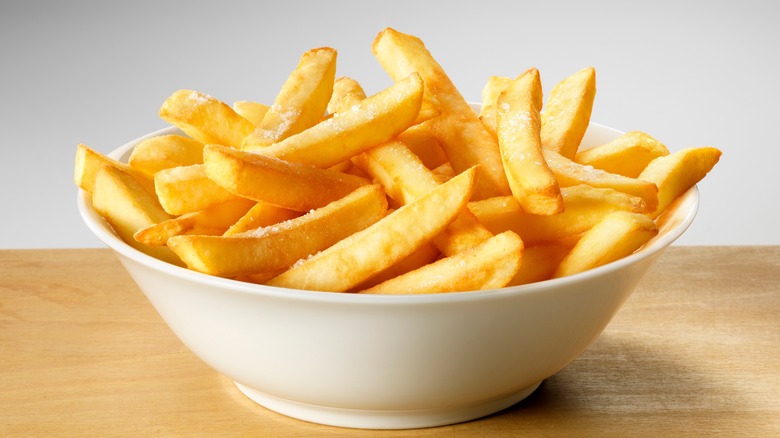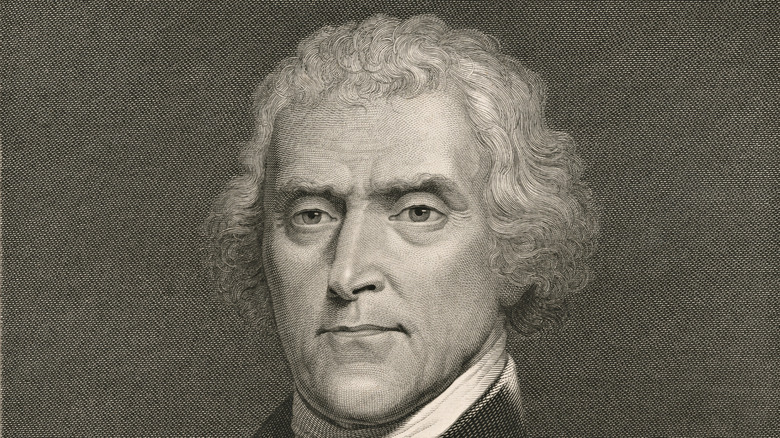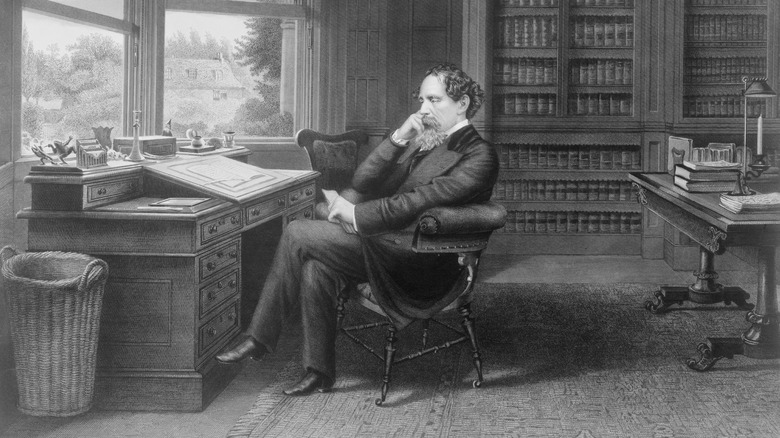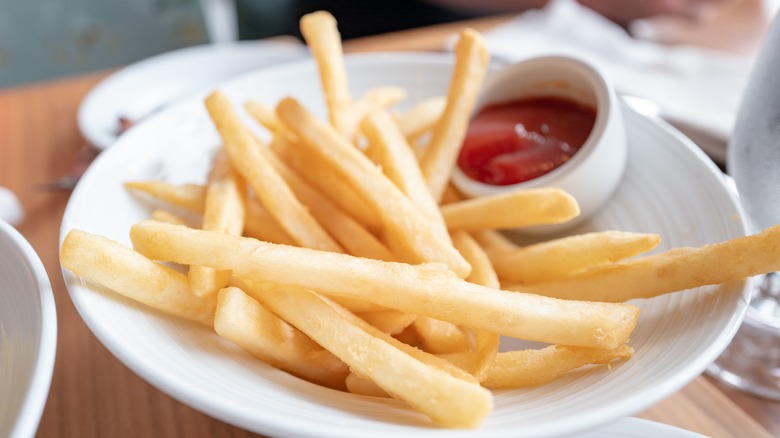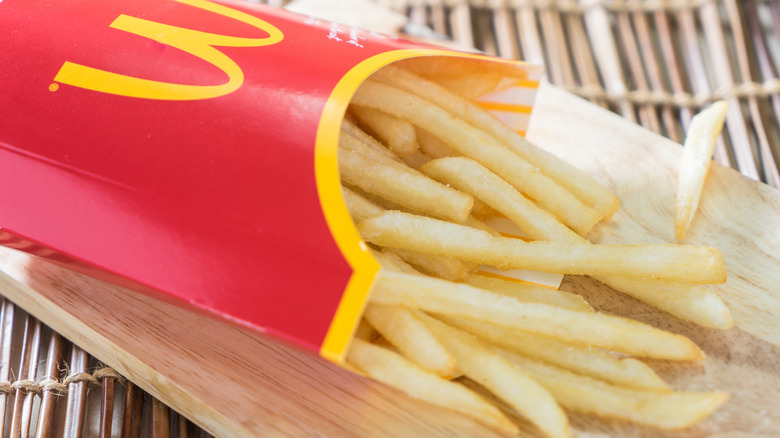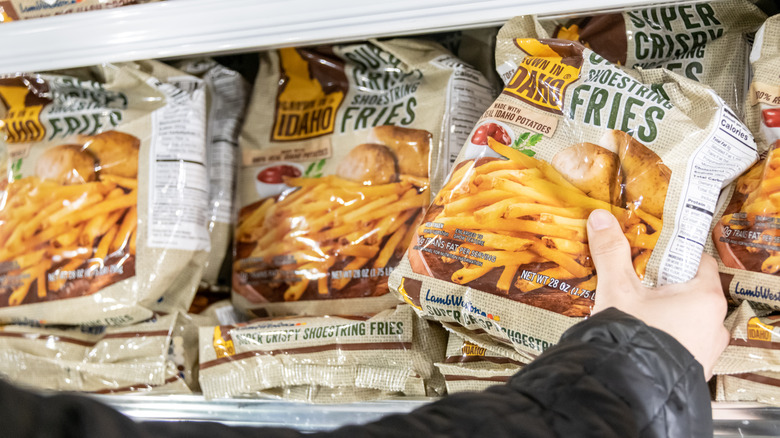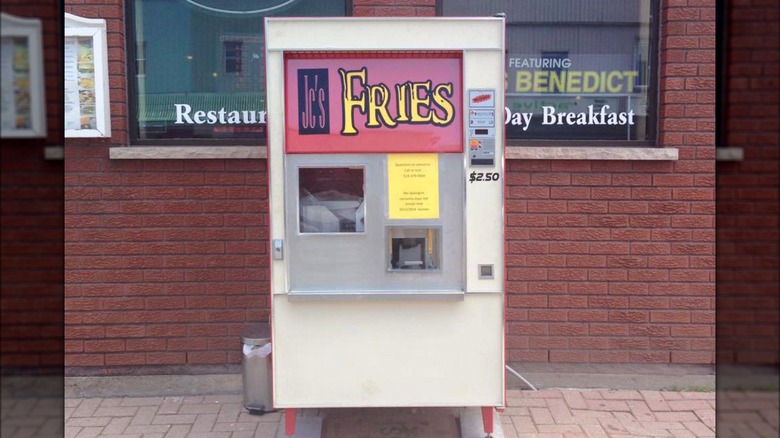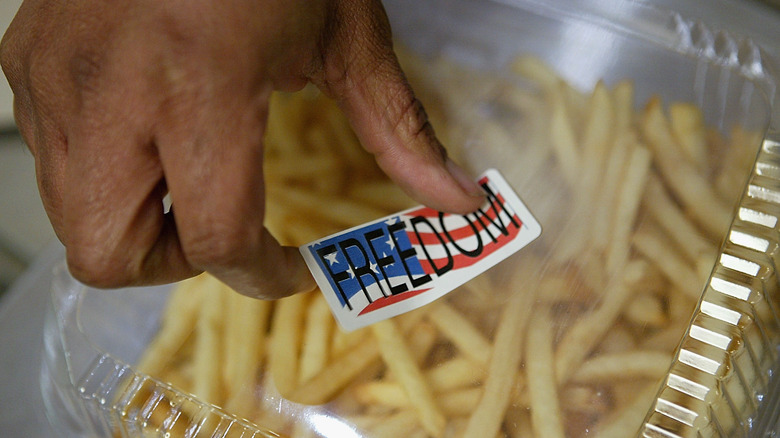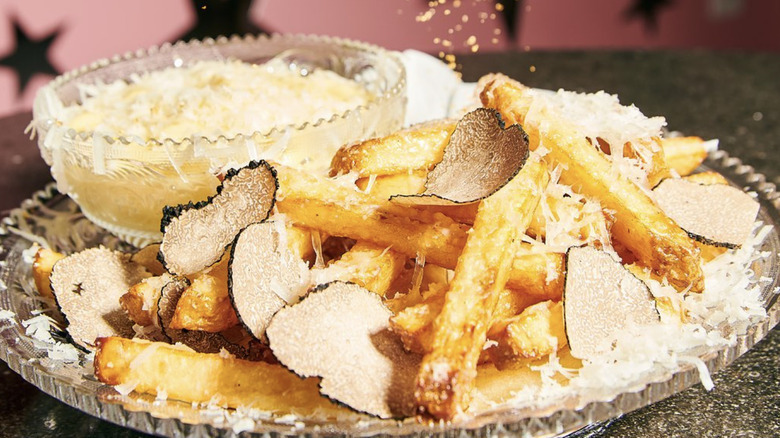The Strange Untold History Of French Fries
There's little doubt that french fries enjoy widespread popularity. According to Grit, Americans eat more than 4.5 billion pounds of the fast food staple each year. For the average American, that's 29 pounds of french fries, the equivalent of 77 large servings of McDonald's french fries a year (via National Geographic). However, it's not just Americans who are enamored with these golden pieces of potato perfection. French fries have become a global phenomenon, transcending countries, cuisines, and cultures. Just think about Canadian poutine, South African slap chips, and Belgian frites with mayonnaise.
There are a few good reasons why french fries are the darling of the fast food industry. Their distinctive blend of crispy exteriors and fluffy interiors makes for a satisfying textural experience that's hard to resist. Beyond their unique taste, french fries offer a comforting familiarity, and their finger-food status means that they can be easily shared during social gatherings. In addition, french fries also make the perfect side dish to other fast food offerings such as burgers and fried fish.
If you thought you knew everything there is to know about french fries, think again. The crispy strips of goodness come with a fascinating history. Keep reading to find out more!
The origins of french fries are uncertain
The story of french fries goes back to the early 15th century when the Spanish conquistadors brought spuds back home after their sojourns in Peru and Bolivia. However, to say that potatoes weren't a straight-out hit would be an understatement. In fact, many Europeans at the time were convinced that spuds were poisonous.
According to some accounts, french fries were first invented in Belgium in 1680. It's said that when fish weren't available to fry one winter because the River Meuse was frozen, residents began frying potatoes instead, giving rise to the birth of french fries. Others theorize that french fries came decades later, after potatoes arrived in the region in 1735. It's uncertain whether Belgium is indeed the birthplace of the humble fry. Nevertheless, some folks in the country have been petitioning UNESCO to recognize french fries as a cultural treasure of Belgium.
Then again, just like their name suggests, french fries may be a French invention. According to an alternative version of events, the idea for french fries was transplanted to France by a French Army pharmacist named Antoine-Augustin Parmentier who learned about potatoes during his imprisonment in a Prussian prison in the mid-18th century. Advocates of this story assert that the first version of french fries was called pommes Pont-Neuf and was sold by Paris pushcart vendors during the latter part of the 18th century.
Thomas Jefferson was a big fan of french fries
The third president of the United States, Thomas Jefferson, had a strong appreciation for French cuisine, including a fondness for a version of what we now know as french fries. It's more than likely that Jefferson's stint as the U.S. Minister to France between 1785 and 1789 influenced his culinary preferences. During his time in France, Jefferson collected around 150 recipes and had his chef and slave, James Hemings, trained in the art of French cooking. Some of these recipes included macaroni and cheese, vanilla ice cream, and "pommes de terre frites a cru en petites tranches," which translates to deep-fried small slices of raw potato.
Jefferson is commonly recognized as the person who introduced Americans to french fries. One White House dinner menu in 1802 included "potatoes served in the French manner." Jefferson's recipe for french fries has been documented in Mary Randolph's "The Virginia House-Wife" of 1824. However, instead of slicing the potatoes into sticks, the recipe instructs that they should be cut "in shavings round and round, as you would peel a lemon" (via National Geographic). Even with presidential endorsement, french fries only started to gain popularity in the U.S. in the 1870s.
Charles Dickens wrote about french fries in one of his novels
Charles Dickens wasn't just one of the most famous novelists of the Victorian era; he was also an avid foodie at a time when the term and concept as we understand it today didn't even exist. As such, it shouldn't come as a surprise that Dickens peppered his novels with elaborate descriptions of his characters' dinner plates. For instance in "The Pickwick Papers," the 19th-century English author mentions no less than 32 dinners, 35 breakfasts, 10 luncheons, and a staggering 249 nods to a variety of beverages.
While french fries weren't a staple of his era's gastronomy, Dickens refers to crunchy potato sticks in his 1859 novel, "A Tale of Two Cities." More specifically, the author describes french fries as "husky chips of potato, fried with some reluctant drops of oil" (via NPR). This savory reference is said to be the first mention of french fries in literature. Whether Dickens was a culinary visionary is debatable. However, it's worth noting that one of Britain's most cherished national dishes, fish and chips, made its appearance in 1863, merely four years after the publication of the author's groundbreaking novel.
The name french fries may have been popularized by American soldiers
While the menu at Thomas Jefferson's 1802 White House dinner featured "potatoes served in the French manner," the snack was being referred to as "French fried potatoes" by the 1850s. We know this because the term appeared in a cookbook entitled "Cookery for Maids of All Work" by E. Warren, which was published in 1856. So how did the term french fried potatoes turn into french fries?
According to folklore, the term french fries (or maybe french fried) was first coined and later popularized by American soldiers posted in the francophone region of Belgium during World War I. An employee at Belgium's museum of fries explains one version of the story, as reported by Frenchly: "During World War I, the Anglo-Saxons fighting on the front lines met French-speaking soldiers eating fries. The Anglo-Saxons thought the soldiers were French, even though they were Belgian! That's how they started being called french fries."
Linguist Stuart Berg Flexner corroborates this story — sort of — saying that french fries were referred to as french fried potatoes until the 1920s. Since World War I ended in 1918, it makes sense that their name would change to french fries after American soldiers returned home from the battlefield (via National Geographic).
French fries didn't appear on the original McDonald's menu
Alongside burgers, french fries are the most popular item at McDonald's. The chain serves about 9 million pounds of french fries each day at over 40,000 locations — that's a massive 3.29 billion pounds of fries annually (via Zippia). With such staggering numbers, it's hard to imagine that french fries didn't actually appear on the fast food restaurant's first menu.
Richard and Mac McDonald opened the first McDonald's in San Bernardino, California, in 1940 as a barbecue restaurant. In 1948 the brothers decided to revamp their venture into a burger joint, narrowing the food menu down to four options: hamburger, cheeseburger, potato chips, and pie. The chain replaced potato chips with french fries a year later in 1949 (this is also the year McDonald's introduced the triple thick milkshake).
While decades have passed since french fries first appeared on McDonald's menu, the side's recipe has remained more or less unchanged, as explained by one of McDonald's quality and supply chain executives, Amy Wilcox, in an interview with Yahoo Finance. "We only use whole potatoes, and they must meet our set of high standards related to size, shape, varietal, color, and storability." They are made into fries and then shipped to restaurants, where "everything from the cook time to the amount of salt is carefully measured," Wilcox said. Perhaps the biggest change to the chain's french fry recipe has been the shift from cholesterol-loaded beef tallow to zero-trans-fat cooking oil.
Frozen french fries were invented by a farmer
French fries account for 85% of all frozen potato products in the U.S., 90% of which are retailed at fast food restaurants, as reported by the U.S. Department of Agriculture. The revolutionary process of freezing cut potatoes was developed in the 1950s by John Richard Simplot. Also sometimes referred to as the Idaho potato baron, Simplot had the brains for business from a very early age. Leaving his family home at the tender age of 14, he tried his hand at everything from raising lambs to turning wild horses into feed. And his entrepreneurial spirit paid off. By 1940, Simplot had become the leading potato shipper in the West. A year later, in 1941, he opened a dehydration plant, which made a fortune supplying American soldiers with dried potatoes and onions during World War II.
Simplot's foray into the frozen fry business came after the popularization of refrigerators equipped with separate freezer compartments in the early 1950s. Although frozen french fries initially found a place on retail shelves, the financial breakthrough for Simplot came when he started selling his product to restaurant owners. In the mid-1960s, Simplot made a deal with Ray Kroc, who had purchased McDonald's in 1961, to start supplying the fast food giant with frozen french fries. The rest, as they say, is history.
The first french fry vending machine appeared in Australia in the 1980s
Most of us don't even realize that french fry vending machines ever existed. And given the prevalence of fast food outlets, it's probably not surprising that they never took off. The first french fry vending machine was invented in the fast food-loving country of Australia in 1982. The vending machine, which was called Mr. French Fry, dispensed a serving of freshly fried golden potato sticks in less than a minute. The company behind the machine is now a thing of the past, and it's pretty safe to say that you won't find any Mr. French Fry vending machines on street corners down under.
Over the years, numerous other companies have also tried developing their own versions of french fry vending machines. Perhaps the most well-known such contraption is the Robo French fry machine invented by a Chinese company called Beyondte Technology in 2008, which was later purchased by Breaktime Solutions in Belgium. Referred to as the "Rolls Royce of vending machines" by the New York Post, the 750-pound Robo French delivered a serving of hot fries in 95 seconds. Unlike previous versions of french fry vending machines, Robo French was engineered to utilize beef fat in the french fry-making process.
U.S. Congress once renamed french fries as freedom fries
While this may seem ridiculous to many, American french fries experienced a temporary name change in 2003. It all began with the U.S. plan to invade Iraq. In preparation for a wartime effort, the U.S. government formed a coalition of nations to back its endeavors. However, France, a long-standing ally of the U.S., was not in favor of the invasion. This didn't sit well with some in Congress, who changed the name of french fries in the Congressional cafeterias to "freedom fries" (similarly, french toast was rebranded as "freedom toast").
The somewhat childish idea originated with North Carolina Rep. Walter B. Jones, a Republican, and was promptly implemented by the chairman of the Committee on House Administration, Bob Ney, also a Republican. Both were inspired by a North Carolina restaurateur who renamed his french fries after learning that during World War I sauerkraut became liberty cabbage and frankfurters were renamed hot dogs. By 2006, french fries were back on the Congressional cafeteria menus.
Not everybody was impressed by the move. According to National Geographic, a poll conducted at the time revealed that 66% of Americans found the move silly. A French Embassy spokeswoman, Nathalie Loiseau, also commented on the name change, saying, "I wonder if it's worth a comment ... Honestly. We are working these days on very, very serious issues of war and peace, life or death. We are not working on potatoes" (via The New York Times).
French fries made it into the book of Guinness World Records
French fries are at the center of two Guinness World Records, highlighting both culinary creativity and enthusiasm for the iconic side dish. The first notable epicurean achievement involved the largest molded french fry. In 2018, Chandresh Bayad in Gujarat, India, created a 24.25-pound french fry, setting the first record for the largest molded french fry.
The second french fry-related Guinness World Record took place at the Serendipity 3 restaurant in New York in 2021. The restaurant turned the fast food staple into a gourmet masterpiece, bagging a record for the most expensive french fries. A serving of Serendipity 3's Crème de la Crème Pommes Frites set diners back a cool $200. So what's the recipe for this decadent treat, you may ask. The most expensive fries in the world were made with upstate chipperbec potatoes, 2006 Dom Perignon Champagne, J. LeBlanc French Champagne Ardenne Vinegar, and goose fat as well as different types of truffle-based condiments from butter to oil. Last but not least, the dish was topped with 23-karat edible gold dust, shaved truffle, and Crete Senesi Pecorino Tartufello cheese.
